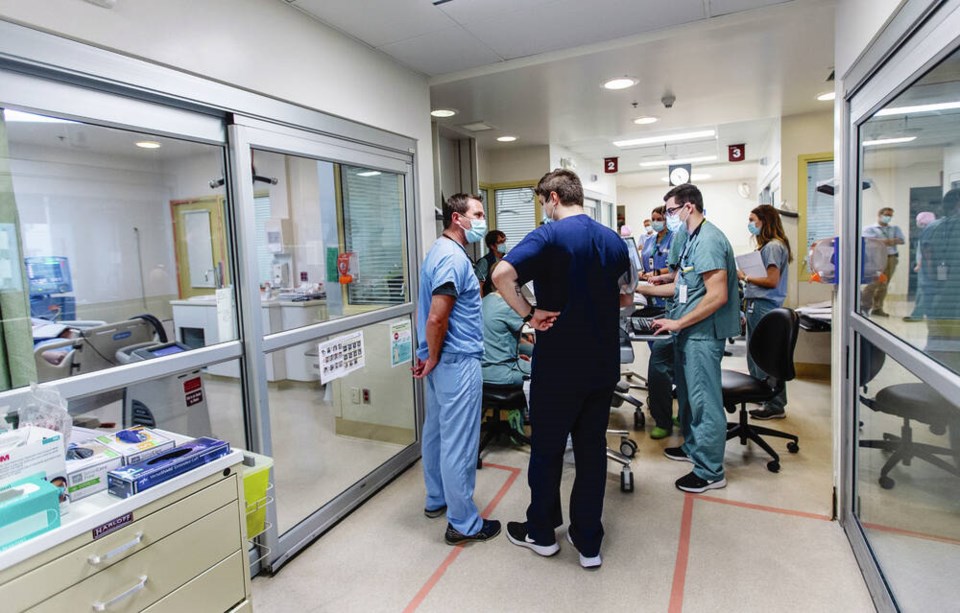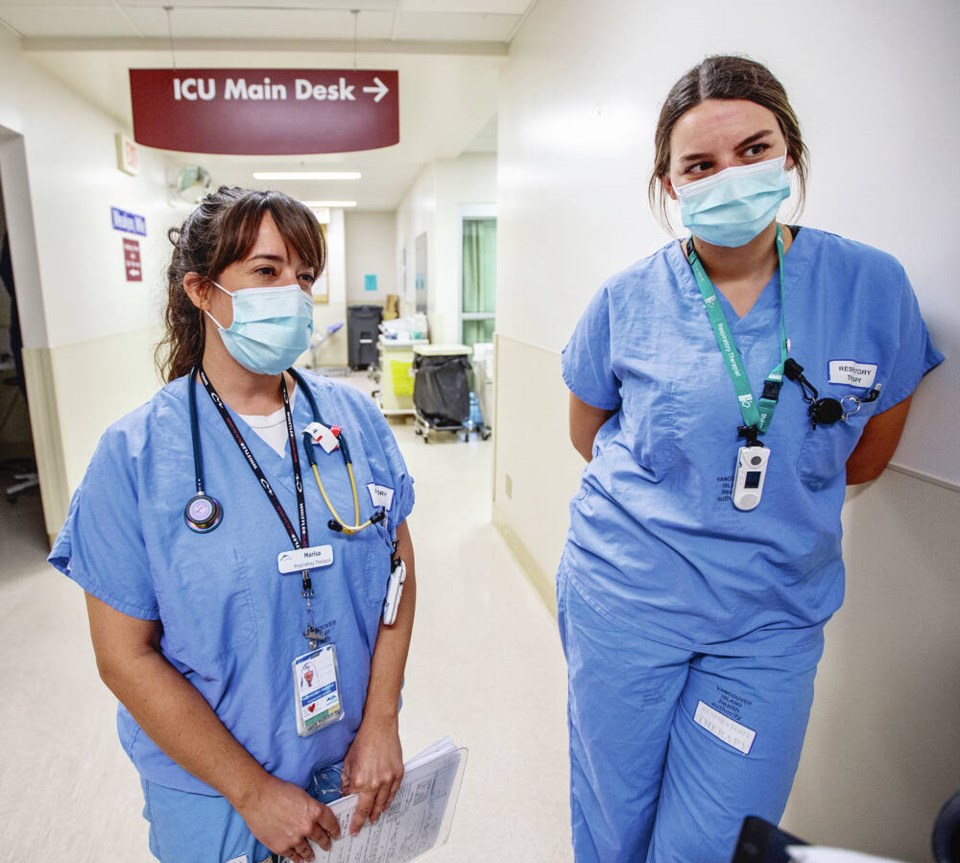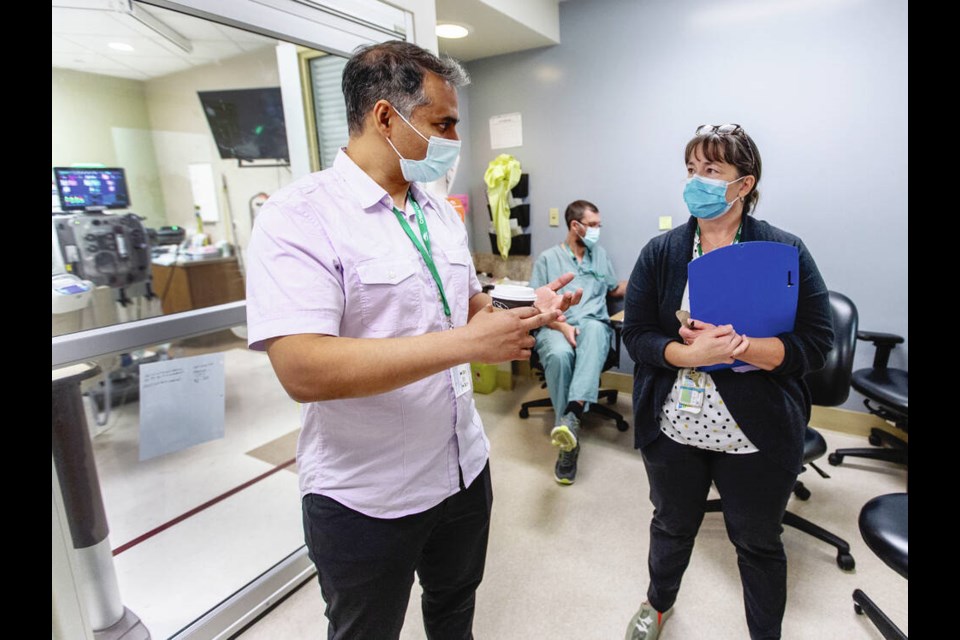A woman sits on a chair in front of the glass wall of her husband’s intensive care room. On the other side of the glass, a white blanket covers a slim man lying chest-down with his face slightly to the side, revealing youthful skin and dark hair.
Admitted with COVID-19 weeks ago, he is now heavily sedated, alone and on life support.
What’s unfolding in Room 5 on this day in the intensive care unit of Royal Jubilee Hospital in Victoria — and in countless other rooms in other ICUs — tells the story of the pandemic’s fourth wave. (No names or identifying information are being shared for privacy reasons, and the room number has been changed.)
On this day, outside this room, the purposeful movements and furrowed brows of health-care workers moving between here and a meeting room signal something is very wrong.
Matt Marshall, an ICU social worker, remains by the woman’s side, a practicum student in training hovers, and further down the hall, a wide circle of health-care workers and trainees gathers to discuss a case.
As the woman watches her husband, her caring is so palpable, one could imagine it transcending the glass. Moments later, a gasping cry breaks the stuffy silence of the intensive-care ward.
Then the man’s children are individually and methodically suited up in hospital gowns, masks and face shields and sent — one at a time — into the ICU room. They are prepared by staff for both infection-prevention and the potential trauma of seeing a loved one in this state. “It’s a very emotional time in there,” says ICU registered nurse Carrie Homuth, who manages the adult intensive care unit and high-acuity unit for Royal Jubilee.
One child embraces his sedated father, the next strokes his father’s arm with an ungloved hand. There are more tears.

COVID patients in the ICU are allowed two visitors a day, separately, for an hour a day, although visitors who are COVID-positive or contagious must remain outside the glass. At the end of life, however, families are allowed to be at the bedside.
Island Health has revised some of those restrictions — within provincial guidelines — to allow for a more “humane” experience, with more physical and virtual visits and small graces, such as holding a loved one’s hand.
While some continue to underestimate its deadliness — even its existence — COVID seems both visible and loud in the halls of Royal Jubilee’s fifth-floor ICU.
Picture window after picture window exhibits human beings who are alone in rooms fed air, nutrients and life-saving medications by all manner of machines, tubes and pumps.
They are parents, siblings, sons and daughters, but with no one keeping vigil at their bedsides, these glass cases have the air of a science lab.
A man in his late 30s or early 40s lies surrounded by hundreds of thousands of dollars in equipment — a ventilator has taken over his lung function, a high-end dialysis machine replaces the work of his failed kidneys, and a catheter suctions away gastric fluids and waste.
There are digital monitoring screens of all sizes, and even the bed, valued at about $50,000, is working as it gently massages the body to prevent bed sores.
Dr. Omar Ahmad, who serves as department head for emergency and critical care for Island Health, says every tube and machine is vital to keeping the patient alive.
COVID progresses differently based on each patient’s physiology and underlying health, he says, but many people report feeling at first like they have the flu — typically five to 10 days after infection. Some describe a loss of taste or smell, brain fog, extreme exhaustion and being winded. If you’re lucky, he says, you just feel “completely miserable.”
Some, however, experience worsening oxygen levels, and by day 7 to 11 after diagnosis, many are sick enough to end up in hospital. Patients talk about “air hunger” — the medical term is dyspnea. They may take 30 to 40 breaths a minute, but feel like they can’t catch a breath, Ahmad says. Some describe a sense of choking, which leads to growing anxiety.
With COVID pneumonia, many patients also talk about significant pain in their lungs and chests, Ahmad says.
“Every time they cough, there’s excruciating pain. They feel like they’re going to die. They feel like they’re going to pass out — they just don’t feel they can get enough air.”
Patients can also develop life-threatening blood clots in their lungs or elsewhere throughout their bodies. If their condition worsens, they are admitted to the intensive care unit.
Once they’re on a ventilator, it’s a “very, very rocky course,” Ahmad says.
He says data from across the province show that since the Delta variant become the dominant strain, more than 50 per cent of people who end up on a mechanical ventilator die. “It’s a very high mortality rate.”
A Canadian Institute for Health Information report released in September on COVID-19 hospitalizations from April to June 2021 said more than one in four hospital admissions included a stay in the ICU, and among those ICU admissions, 64 per cent received ventilation — 23 per cent of whom died in the facility. That was before the Delta variant took hold in B.C.
COVID attacks the lungs, but as it progresses, it can also affect the kidneys, brain, liver and heart, eventually leading to multi-organ system failure, Ahmad says.
While non-COVID pneumonia patients who are ventilated will typically recover with antibiotics over the course of a week if they are otherwise healthy, that’s not often the case with COVID pneumonia patients, he says.
While there are some success stories, “we’re finding these COVID pneumonia patients don’t turn around quickly.”
A lot of young or fit people have a “false sense of security” they can beat COVID, “but we’ve unfortunately seen many people with that description becoming very sick and going on to die,” Ahmad says. “We see this more commonly than we would hope.”
Fully vaccinated people who get infected and end up in the ICU are often frail and elderly with multiple medical problems, but doctors have begun to see more vaccinated patients who are older, but otherwise fit and healthy, becoming seriously ill or, in a few cases, even dying, which Ahmad says speaks to the virulence of the Delta variant.
“In health care, we shudder when we think of the devastation that would have ensued had we not had a vaccine.”
In the coming weeks, Royal Jubilee Hospital will have the largest ICU on the Island, growing out of necessity amid the pandemic.
The main ICU is 11 beds, but a high-acuity unit that opened on the third floor a year ago with six beds and grew to eight is now morphing into an ICU of its own, one that will eventually expand to 17 bed. That will make 28 beds available for critically ill patients at Royal Jubilee alone.
As the pandemic hit a third wave in March and a fourth wave by August, the new high acuity unit, created through fundraising efforts by the Victoria Hospitals Foundation, became the defacto ICU 2, says Ahmad.
Homuth says she can’t imagine how Island Health would have gotten through the fourth wave without the new unit at Royal Jubilee, one of the Island’s three designated COVID hospitals, along with Nanaimo Regional General Hospital and North Island Hospital Comox Valley in Courtenay. Victoria General Hospital also began taking on COVID patients in recent months.
The expansions, however, come with both labour and physical challenges.
Royal Jubilee’s high-acuity unit, for instance, does not have the glass walls health-care workers use to monitor patients in ICUs, or come with the same staffing or equipment.
The solid doors in the high-acuity unit must be kept shut because patients are infectious, but that removes the auditory and visual cues ICU staff rely on for fragile patients. Even when limited staff are in the room, those on the outside can’t anticipate what’s needed by the crew inside. “It isn’t the best scenario,” says Homuth.
The Victoria Hospitals Foundation has raised more money to go toward making those changes when the pandemic eases.
Then there is the question of staffing. Critical-care nurses are being pulled from other hospitals, other Royal Jubilee wards, clinics and the community to staff the expanding unit.
“This is a care area where only a select few people have the capacity to provide this level of care, ” says Homuth, who trains ICU nurses. “It takes us almost two years to grow a good critical-care nurse.”
On the day of the Times Colonist’s visit, eight of the 11 ICU beds at Royal Jubilee Hospital are full. All eight patients have COVID, including one who is no longer infectious.
Twelve of the high-acuity beds available are occupied, and seven of those patients have COVID.
Looking at the COVID patients, all on ventilators, it’s impossible to tell who is categorized as “recovered” and who is an active case.
“They all look the same, but they are no longer contagious,” Homuth says. “They are still suffering from the effects of COVID and they look like everyone else — we just don’t have to use the same precautions.”

Asked how many patients will likely be discharged to return home, Homuth says doctors and nurses have stopped trying to forecast that.
Some COVID patients in the ICU will appear to be recovering and have a ventilator removed, for instance, and then crash and “get very sick, very quickly,” and all the machines and tubes will need to be reinserted. “When people get that hopefulness, there’s only so many times that can be dashed before we stop trying to predict,” Homuth says. Non-contagious COVID patients can still relapse and die.
Critical-care nurse Becky Fontaine, who teaches nursing students from the B.C. Institute of Technology, has the difficult task of having to tell a lot of students their patients likely won’t make it.
“It’s a bit tricky to teach right now — these patients are so sick,” Fontaine says. “Our senior nurses are struggling keeping up with this.”
Typically, if a patient is palliative, a lot of support can be put in place to ensure “people can pass away in peace and dignity surrounded by their family,” Fontaine says. That’s harder amid a pandemic, even with recently relaxed rules.
“Being there as family is on the glass, on the ground crying, and you’re the one in the room trying to support that family — it’s draining, it’s hard on the soul,” she says. “We’ve lost tons of nurses. There’s a good few here that we’ve asked to come back and they have, but not everybody. It’s about their mental health, or they have children at home.”
Fontaine says she tries to tell trainees they’ll hopefully never experience another pandemic in their lifetime.
Respiratory therapists Marisa McGovern and Haley Lehr admit they are exhausted by the fourth wave, with more patients who are sicker than ever.
“It’s been all hands on deck at all times,” says McGovern. “Shifts are busier than they’ve ever been and we’re constantly short-staffed.”
Lehr says many of her co-workers are burnt out and seeing more patients than they “safely should be.”
The two say they haven’t considered quitting or calling in sick, however, “because we’re all in this together — I don’t want to see my co-workers drowning or pulling staff from other areas of the hospital,” says McGovern. “We’re just trying to make it through every day.”
Physically, they are on their feet all day — with lunches, coffee breaks, even bathroom breaks often going by the wayside — while mentally, they are having to reconcile seeing young adults their age suffer or die from an “easily preventable” disease, says McGovern.
“The toughest part for me has been seeing the progression of someone coming into the hospital with COVID, and they can speak to you and then when it comes time to put the breathing tube in, you know this may be the last time they ever speak and we’re the ones to hear that — ‘help me breathe’ or ‘am I going to make it through? Am I going to die?’ ”


